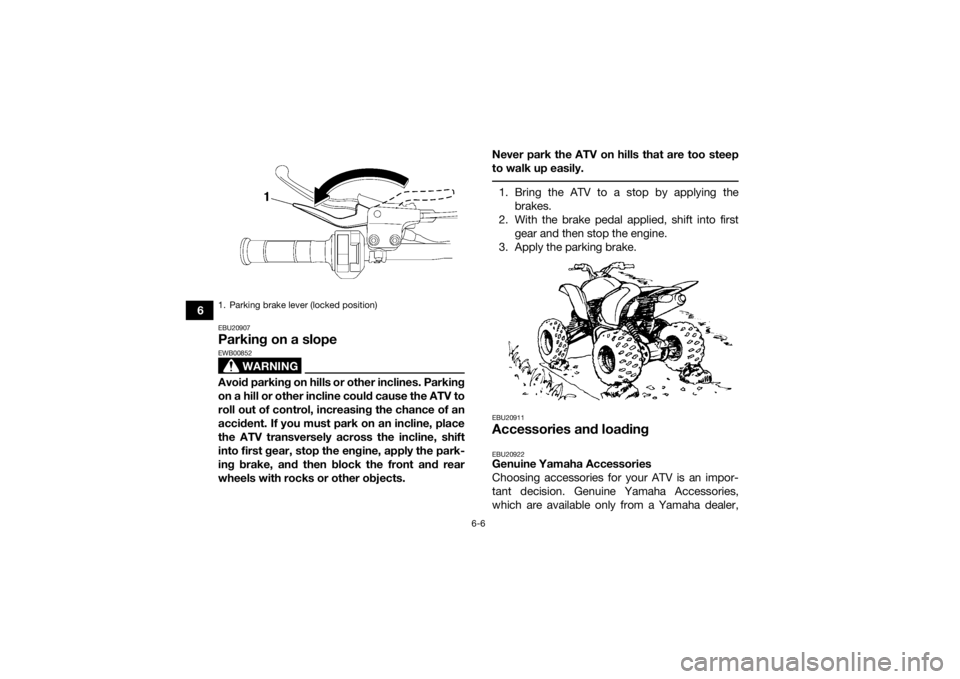Page 65 of 160

6-3
6
4. Open the throttle gradually and at the same
time, release the clutch lever slowly.
WARNING! Opening the throttle abruptly or releasing the clutch lever too quickly
could make the ATV wheelie, which would
increase the chance of an accident, in-
cluding an overturn.
[EWB00732]
5. Once the ATV has attained adequate speed, release the throttle, and at the same time,
quickly pull in the clutch lever.
6. Shift the transmission into second gear. (Make sure not to shift the transmission into
neutral.)
7. Open the throttle part way and gradually re- lease the clutch lever.
8. Follow the same procedure when shifting to the next higher gear.EBU20653To decelerate
When slowing down or stopping, release the
throttle and apply the brakes smoothly and evenly.
As you slow down, shift to a lower gear. Be sure
that the engine has sufficiently slowed before en-
gaging a lower gear. Improper use of the brakes or shifting can cause the tires to lose traction, reduc-
ing control and increasing the possibility of an ac-
cident.
WARNING
EWB00712Make sure the engine has sufficiently slowed
before shifting to a lower gear. Engaging a low-
er gear when the engine speed is too high
could make the wheels stop rotating and lose
traction. This could cause loss of control, an
accident and injury. It could also cause engine
or drivetrain damage. NOTICEECB00181
Even with the transmission in the neutral po-
sition, do not coast for long periods of time
with the engine off, and do not tow the ATV
for long distances. The transmission is prop-
erly lubricated only when the engine is run-
ning. Inadequate lubrication may damage
the transmission.
U2LS62E0.book Page 3 Thursday, February 25, 2016 8:44 AM
Page 66 of 160

6-4
6
Always use the clutch when changing gears.
The engine, transmission and drive train are
not designed to withstand the shock of
forced shifting and can be damaged by shift-
ing without using the clutch.
EBU20503Operating the reverse knob and driving
in reverse
WARNING
EWB00721Improper operation in reverse could make you
hit an obstacle or even a person behind you,
resulting in serious injury. When you shift into
reverse, make sure there are no people or ob-
stacles behind you. When it is safe to proceed,
go slowly. NOTICEECB00171Before shifting, stop the ATV, otherwise the
transmission may be damaged. 1. Bring the ATV to a complete stop, apply the
clutch lever, and then shift the transmission
into first gear. 2. While applying the brake pedal, turn the re-
verse knob clockwise with your right hand.
3. Shift the transmission into reverse by press- ing down on the shift pedal, and then release
the reverse knob.
TIPWhen in reverse, the reverse indicator light should
come on. If the indicator light does not come on,
have a Yamaha dealer check the electrical circuit. 4. Check behind you for people or obstacles,and then release the brake pedal.1. Reverse knob “REV”
2. Shift pedal
2
1
U2LS62E0.book Page 4 Thursday, February 25, 2016 8:44 AM
Page 67 of 160

6-5
6
5. Open the throttle lever gradually and release
the clutch lever slowly. Continue to watch to
the rear while backing.
EBU20673Engine break-inTIPFor ATVs equipped with an odometer or an hour
meter, follow the figures given in km (mi) or the
figures given in hours.
For ATVs not equipped with an odometer or
hour meter, follow the figures given in hours. There is never a more important period in the life
of your engine than the first 320 km (200 mi) or 20
hours of riding. For this reason, you should read
the following material carefully.
Since the engine is brand new, do not put an ex-
cessive load on it for the first 320 km (200 mi) or
20 hours. The various parts in the engine wear and
polish themselves to the correct operating clear-
ances. During this period, prolonged full-throttle
operation or any condition that might result in en-
gine overheating must be avoided. 0–160 km (0–100 mi) or 0–10 hours
Avoid prolonged operation above 1/2 throttle.
Vary the speed of the ATV regularly. Do not oper-
ate it at one set throttle position.
160–320 km (100–200 mi) or 10–20 hours
Avoid prolonged operation above 3/4 throttle. Rev
the engine through the gears freely, but do not use
full throttle at any time.
320 km (200 mi) or 20 hours and beyond
The ATV can now be operated normally.
NOTICEECB00221If any engine trouble should occur during the
engine break-in period, immediately have a
Yamaha dealer check the ATV. EBU26762ParkingWhen parking the ATV, shift into first gear, stop
the engine, and then apply the parking brake.
U2LS62E0.book Page 5 Thursday, February 25, 2016 8:44 AM
Page 68 of 160
6-6
6
EBU20907Parking on a slope
WARNING
EWB00852Avoid parking on hills or other inclines. Parking
on a hill or other incline could cause the ATV to
roll out of control, increasing the chance of an
accident. If you must park on an incline, place
the ATV transversely across the incline, shift
into first gear, stop the engine, apply the park-
ing brake, and then block the front and rear
wheels with rocks or other objects.Never park the ATV on hills that are too steep
to walk up easily.
1. Bring the ATV to a stop by applying the
brakes.
2. With the brake pedal applied, shift into first gear and then stop the engine.
3. Apply the parking brake.EBU20911Accessories and loadingEBU20922Genuine Yamaha Accessories
Choosing accessories for your ATV is an impor-
tant decision. Genuine Yamaha Accessories,
which are available only from a Yamaha dealer,
1. Parking brake lever (locked position)U2LS62E0.book Page 6 Thursday, February 25, 2016 8:44 AM
Page 69 of 160

6-7
6
have been designed, tested, and approved by
Yamaha for use on your ATV. Many companies with no connection to Yamaha manufacture parts
and accessories or offer other modifications for
Yamaha vehicles. Yamaha is not in a position to test the products that these aftermarket compa-
nies produce. Therefore, Yamaha can neither en-
dorse nor recommend the use of accessories not
sold by Yamaha or modifications not specifically
recommended by Yamaha, even if sold and in-
stalled by a Yamaha dealer.
Aftermarket parts, accessories, and modifica-
tions
While you may find aftermarket products similar in
design and quality to genuine Yamaha Accesso-
ries, recognize that some aftermarket accessories
or modifications are not suitable because of po-
tential safety hazards to you or others. Installing
aftermarket products or having other modifica-
tions performed to your ATV that change any of
the vehicle’s design or operation characteristics
can put you and others at greater risk of serious
injury or death. You are responsible for injuries re-
lated to changes in the vehicle. Keep the following in mind when considering an
accessory or operating an ATV which has acces-
sories.
Accessories should be rigidly and securely
mounted. An accessory which can shift position
or come off while you are riding could affect
your ability to control the ATV.
Do not mount an accessory where it could inter-
fere with your ability to control the ATV. Exam-
ples include (but are not limited to) a heavy or
bulky object attached to the handlebars which
could make steering difficult, an accessory that
limits your ability to move around on the seat, or
one that limits your view.
Use extra caution when riding an ATV with ac-
cessories. The ATV may handle differently than
it does without accessories.
EBU20942Loading
WARNING
EWB00821Never exceed the stated load capacity for this
ATV. Overloading this ATV or carrying or tow-
ing cargo improperly could cause changes in
ATV handling which could lead to an accident.
Cargo should be properly distributed and se-
U2LS62E0.book Page 7 Thursday, February 25, 2016 8:44 AM
Page 70 of 160

6-8
6curely attached. Reduce speed when carrying
cargo or pulling a trailer. Allow greater dis-
tance for braking.
As originally equipped, this ATV is not designed to
carry cargo or tow a trailer. If you choose to add
accessories so that you can carry cargo or tow a
trailer, you must use common sense and good
judgment as the stability and handling of an ATV
can be changed. When adding accessories, keep
the following points in mind:
Never exceed the weight limits shown. An over-
loaded ATV can be unstable.
If you are carrying cargo and towing a trailer, in-
clude the tongue weight in the maximum ATV
load limit.
Load cargo on the carriers as close to the center
of the ATV as possible. Put cargo at the rear of
the front carrier, at the front of the rear carrier,
and center it.
Tie down cargo securely to the carriers. Make
sure cargo in the trailer cannot move around. A
shifting load can cause an accident.
Make sure the load does not interfere with con-
trols or your ability to see where you are going.
Ride more slowly than you would without a
load. The more weight you carry, the slower you
should go. Although conditions vary, it is good
practice not to exceed 2nd gear whenever you
are carrying heavier loads or when towing a
trailer.
Allow more braking distance. A heavier ATV
takes longer to stop.
Avoid making sharp turns unless at very slow
speeds.
Avoid hills and rough terrain. Choose terrain
carefully. Added weight affects the stability and
handling of the ATV.
MAXIMUM LOADING LIMIT
ATV loading limit (total weight of rider, car-
go, accessories, and tongue):100.0 kg (220 lb)U2LS62E0.book Page 8 Thursday, February 25, 2016 8:44 AM
Page 71 of 160
7-1
7
EBU21142
RIDING YOUR ATV
U2LS62E0.book Page 1 Thursday, February 25, 2016 8:44 AM
Page 72 of 160

7-2
7
EBU21619GETTING TO KNOW YOUR ATV
This ATV is intended for recreational use by expe-
rienced operators only. This section, Riding your
ATV, provides general ATV riding instructions for
recreational riding. The skills and techniques de-
scribed in this section, however, are appropriate
for all types of riding. Riding your ATV requires
special skills acquired through practice over a pe-
riod of time. Take the time to learn the basic tech-
niques well before attempting more difficult
maneuvers.
Riding your new ATV can be a very enjoyable ac-
tivity, providing you with hours of pleasure. But it
is essential to familiarize yourself with the opera-
tion of the ATV to achieve the skill necessary to
enjoy riding safely. Before you begin to ride, be
sure you have read this Owner’s Manual com-
pletely and understand the operation of the con-
trols. Pay particular attention to the safety
information on pages 2-1–2-6. Also read all warn-
ing and notice labels on your ATV.RIDE WITH CARE AND GOOD JUDGMENT
Get training if you are inexperienced.
WARNING
EWB01382
Do not operate this ATV or allow anyone else
to operate it without proper instruction. The
risk of an accident is greatly increased if the
operator does not know how to operate the
ATV properly in different situations and on
different types of terrain.
Do not operate this ATV at speeds too fast
for your skills or the conditions, as this in-
creases your chances of losing control of the
ATV and an accident. Always go at a speed
that is proper for the terrain, visibility and op-
erating conditions, and your experience. Beginning and inexperienced operators should
regularly practice the skills and the operating
techniques described in this Owner’s Manual.
Riding your ATV requires skills acquired
through practice over a period of time.
Do not attempt to operate at maximum perfor-
mance until you are totally familiar with the ATV’s
handling and performance characteristics. Take
U2LS62E0.book Page 2 Thursday, February 25, 2016 8:44 AM
 1
1 2
2 3
3 4
4 5
5 6
6 7
7 8
8 9
9 10
10 11
11 12
12 13
13 14
14 15
15 16
16 17
17 18
18 19
19 20
20 21
21 22
22 23
23 24
24 25
25 26
26 27
27 28
28 29
29 30
30 31
31 32
32 33
33 34
34 35
35 36
36 37
37 38
38 39
39 40
40 41
41 42
42 43
43 44
44 45
45 46
46 47
47 48
48 49
49 50
50 51
51 52
52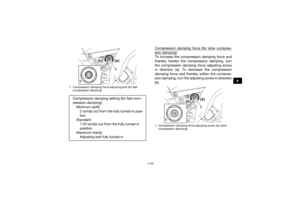 53
53 54
54 55
55 56
56 57
57 58
58 59
59 60
60 61
61 62
62 63
63 64
64 65
65 66
66 67
67 68
68 69
69 70
70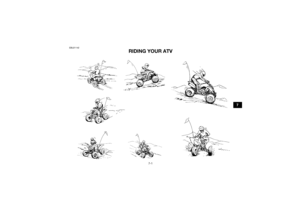 71
71 72
72 73
73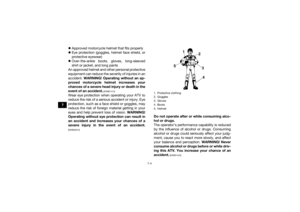 74
74 75
75 76
76 77
77 78
78 79
79 80
80 81
81 82
82 83
83 84
84 85
85 86
86 87
87 88
88 89
89 90
90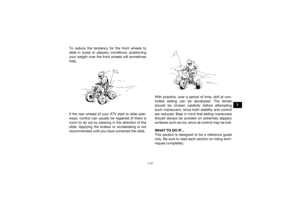 91
91 92
92 93
93 94
94 95
95 96
96 97
97 98
98 99
99 100
100 101
101 102
102 103
103 104
104 105
105 106
106 107
107 108
108 109
109 110
110 111
111 112
112 113
113 114
114 115
115 116
116 117
117 118
118 119
119 120
120 121
121 122
122 123
123 124
124 125
125 126
126 127
127 128
128 129
129 130
130 131
131 132
132 133
133 134
134 135
135 136
136 137
137 138
138 139
139 140
140 141
141 142
142 143
143 144
144 145
145 146
146 147
147 148
148 149
149 150
150 151
151 152
152 153
153 154
154 155
155 156
156 157
157 158
158 159
159


